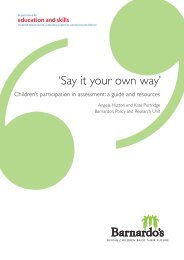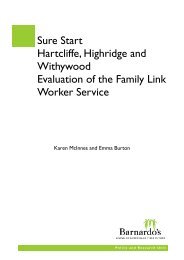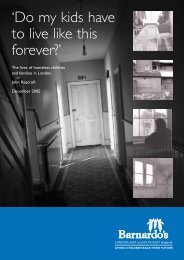Splintered Lives - Barnardo's
Splintered Lives - Barnardo's
Splintered Lives - Barnardo's
You also want an ePaper? Increase the reach of your titles
YUMPU automatically turns print PDFs into web optimized ePapers that Google loves.
PAGE 68<br />
chapter<br />
11 Child protection responses<br />
There are two central problems which currently hinder the development of a child<br />
protection and child welfare framework on sexual exploitation.<br />
Firstly, the majority of child protection training, guidelines and published work focuses<br />
on abuse in a familial context. This is in turn reflected within explanatory frameworks,<br />
accepted modes of intervention and support services. The individual case work<br />
approach is ill-suited where many children are involved, where abusers are organized<br />
and may be linked into criminal networks. Whilst some police officers have skills and<br />
knowledge which enable a different form of response, few social work departments and<br />
child welfare organisations do.<br />
Secondly, and in some ways as a consequence or by product of the first issue, much of<br />
the police work, especially in relation to prostitution, is located within 'vice' sections or<br />
crime desks, and referrals are seldom made to child protection sections of the police, let<br />
alone other agencies. A Children's Society paper (1994a) pointed to ways in which girls<br />
were being "punished and labelled prostitutes rather than protected as victims of sexual<br />
abuse" (p1). These under 16's were not being dealt with by police under the Children<br />
Act, but soliciting legislation. Home Office figures analysed by the Children's Society<br />
revealed an increase of 35% in girls under 16 cautioned during the years whilst the<br />
Children Act was being implemented. These young women are being cautioned for<br />
soliciting when, in law, they are not deemed old enough to consent to sex. They were,<br />
and continue to be, treated differently to under 16 year old girls where sex occurs in the<br />
'private' context of home or care/educational institution.<br />
Organised abuse cases involve communities, networks of relationships, and<br />
considerable efforts are made to protect rings and networks, so that even if it is exposed<br />
only elements of it are broken. We have already highlighted the additional costs of<br />
disclosure to a child/young person. Peter Bibby (1991) uses a spider's web analogy,<br />
pointing out that if only one strand is broken others will continue to entrap those within<br />
it, and the whole web can relatively easily be rebuilt. Children and young people are<br />
only really protected and provided with other options if almost all the strands in the web<br />
are broken. The experience of Social Services Departments (SSDs) who have been<br />
involved in large scale sex ring cases reveal the need for different forms of investigation<br />
and evidence gathering and different forms of support for children and young people. In<br />
some of the more complex and extensive networks what may be needed are similar<br />
levels of organisation to that of the abuse networks themselves. In some instances we<br />
are talking about individuals who have abused many children, and children and young<br />
people who have been repeatedly abused in variety of ways and contexts. Goldstein<br />
(1984) provides some chilling figures from offenders: a 52 year old man said he had<br />
molested 5000 boys; a 42 year old more than 1000; and a 62 year old executive a boy a<br />
day for 30 years.<br />
Don Redding (1989) reflects on what was learnt in 'Operation Hedgerow', an<br />
investigation of a ring in Brent which resulted in 14 men being convicted of offenses<br />
against boys. 150 boys were interviewed and 653 separate allegations made. The boys
















